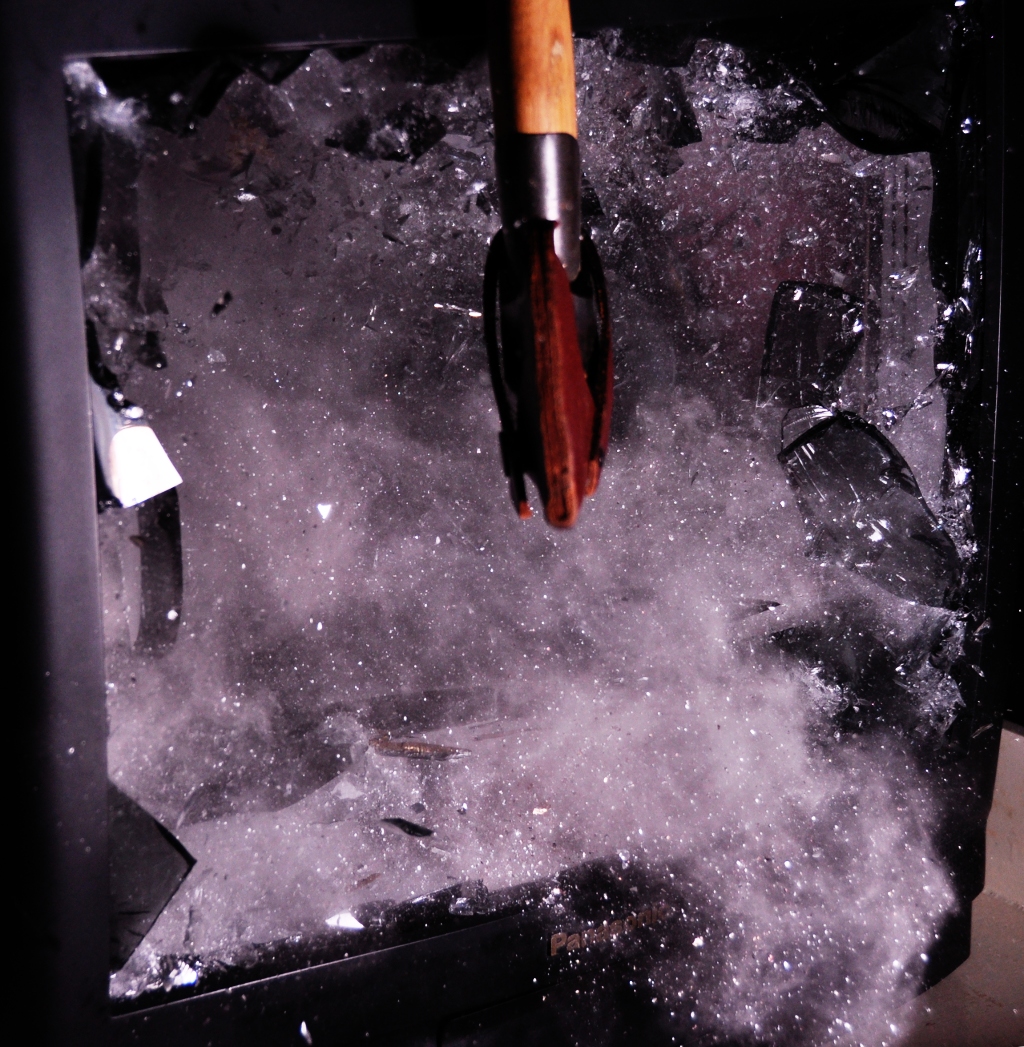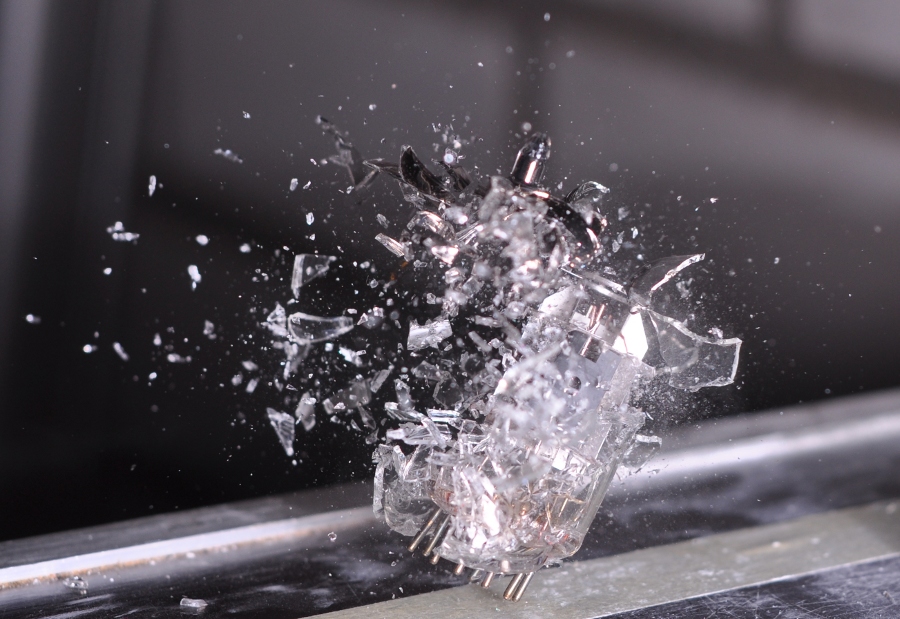Implosion (mechanical process) on:
[Wikipedia]
[Google]
[Amazon]
Implosion is a process in which objects are destroyed by collapsing (or being squeezed in) on themselves. The opposite of


Converging Shock Waves
Mechanics
explosion
An explosion is a rapid expansion in volume associated with an extreme outward release of energy, usually with the generation of high temperatures and release of high-pressure gases. Supersonic explosions created by high explosives are known ...
(which expands the volume
Volume is a measure of occupied three-dimensional space. It is often quantified numerically using SI derived units (such as the cubic metre and litre) or by various imperial or US customary units (such as the gallon, quart, cubic inch). ...
), implosion reduces the volume occupied and concentrates matter
In classical physics and general chemistry, matter is any substance that has mass and takes up space by having volume. All everyday objects that can be touched are ultimately composed of atoms, which are made up of interacting subatomic part ...
and energy
In physics, energy (from Ancient Greek: ἐνέργεια, ''enérgeia'', “activity”) is the quantitative property that is transferred to a body or to a physical system, recognizable in the performance of work and in the form of ...
. True implosion usually involves a difference between internal (lower) and external (higher) pressure, or inward and outward forces, that is so large that the structure collapses inward into itself, or into the space it occupied if it is not a completely solid object. Examples of implosion include a submarine being crushed from the outside by the hydrostatic pressure
Fluid statics or hydrostatics is the branch of fluid mechanics that studies the condition of the equilibrium of a floating body and submerged body " fluids at hydrostatic equilibrium and the pressure in a fluid, or exerted by a fluid, on an i ...
of the surrounding water, and the collapse of a massive star
A star is an astronomical object comprising a luminous spheroid of plasma (physics), plasma held together by its gravity. The List of nearest stars and brown dwarfs, nearest star to Earth is the Sun. Many other stars are visible to the naked ...
under its own gravitational pressure.
An implosion ''can'' propel material outward (for example due to the force of inward falling material rebounding, or peripheral material being ejected as the inner parts collapse), but this is not an essential component of an implosion and not all kinds of implosion will do so. If the object was previously solid, then implosion usually requires it to take on a more dense form - in effect to be more concentrated, compressed, denser, or converted into a new material that is denser than the original.
Examples
Nuclear weapons
In an implosion-typenuclear weapon design
Nuclear weapon designs are physical, chemical, and engineering arrangements that cause the physics package of a nuclear weapon to detonate. There are three existing basic design types:
* pure fission weapons, the simplest and least technically ...
, a sphere of plutonium
Plutonium is a radioactive chemical element with the symbol Pu and atomic number 94. It is an actinide metal of silvery-gray appearance that tarnishes when exposed to air, and forms a dull coating when oxidized. The element normally exh ...
, uranium
Uranium is a chemical element with the symbol U and atomic number 92. It is a silvery-grey metal in the actinide series of the periodic table. A uranium atom has 92 protons and 92 electrons, of which 6 are valence electrons. Uranium is weak ...
, or other fissile
In nuclear engineering, fissile material is material capable of sustaining a nuclear fission chain reaction. By definition, fissile material can sustain a chain reaction with neutrons of thermal energy. The predominant neutron energy may be t ...
material is imploded by a spherical arrangement of explosive charges. This decreases the material's volume and thus increases its density by a factor of two to three, causing it to reach critical mass
In nuclear engineering, a critical mass is the smallest amount of fissile material needed for a sustained nuclear chain reaction. The critical mass of a fissionable material depends upon its nuclear properties (specifically, its nuclear fi ...
and create a nuclear explosion
A nuclear explosion is an explosion that occurs as a result of the rapid release of energy from a high-speed nuclear reaction. The driving reaction may be nuclear fission or nuclear fusion or a multi-stage cascading combination of the two, ...
.
In some forms of thermonuclear weapons, the energy from this explosion is then used to implode a capsule of fusion fuel before igniting it, causing a fusion reaction (see Teller–Ulam design
A thermonuclear weapon, fusion weapon or hydrogen bomb (H bomb) is a second-generation nuclear weapon design. Its greater sophistication affords it vastly greater destructive power than first-generation nuclear bombs, a more compact size, a lo ...
). In general, the use of radiation to implode something, as in a hydrogen bomb or in laser driven inertial confinement fusion
Inertial confinement fusion (ICF) is a fusion energy process that initiates nuclear fusion reactions by compressing and heating targets filled with thermonuclear fuel. In modern machines, the targets are small spherical pellets about the size of ...
, is known as radiation implosion.
Fluid dynamics
Cavitation
Cavitation is a phenomenon in which the static pressure of a liquid reduces to below the liquid's vapour pressure, leading to the formation of small vapor-filled cavities in the liquid. When subjected to higher pressure, these cavities, ca ...
(bubble formation/collapse in a fluid) involves an implosion process. When a cavitation bubble forms in a liquid (for example, by a high-speed water propeller
A propeller (colloquially often called a screw if on a ship or an airscrew if on an aircraft) is a device with a rotating hub and radiating blades that are set at a pitch to form a helical spiral which, when rotated, exerts linear thrust upon ...
), this bubble is typically rapidly collapsed—imploded—by the surrounding liquid.
Astrophysics
Implosion is a key part of thegravitational collapse
Gravitational collapse is the contraction of an astronomical object due to the influence of its own gravity, which tends to draw matter inward toward the center of gravity. Gravitational collapse is a fundamental mechanism for structure formatio ...
of large star
A star is an astronomical object comprising a luminous spheroid of plasma (physics), plasma held together by its gravity. The List of nearest stars and brown dwarfs, nearest star to Earth is the Sun. Many other stars are visible to the naked ...
s, which can lead to the creation of supernova
A supernova is a powerful and luminous explosion of a star. It has the plural form supernovae or supernovas, and is abbreviated SN or SNe. This transient astronomical event occurs during the last evolutionary stages of a massive star or whe ...
e, neutron star
A neutron star is the collapsed core of a massive supergiant star, which had a total mass of between 10 and 25 solar masses, possibly more if the star was especially metal-rich. Except for black holes and some hypothetical objects (e.g. w ...
s and black hole
A black hole is a region of spacetime where gravity is so strong that nothing, including light or other electromagnetic waves, has enough energy to escape it. The theory of general relativity predicts that a sufficiently compact mass can def ...
s.
In the most common case, the innermost part of a large star (called the core
Core or cores may refer to:
Science and technology
* Core (anatomy), everything except the appendages
* Core (manufacturing), used in casting and molding
* Core (optical fiber), the signal-carrying portion of an optical fiber
* Core, the centra ...
) stops burning and without this source of heat
In thermodynamics, heat is defined as the form of energy crossing the boundary of a thermodynamic system by virtue of a temperature difference across the boundary. A thermodynamic system does not ''contain'' heat. Nevertheless, the term is ...
, the forces holding electron
The electron ( or ) is a subatomic particle with a negative one elementary electric charge. Electrons belong to the first generation of the lepton particle family,
and are generally thought to be elementary particles because they have n ...
s and proton
A proton is a stable subatomic particle, symbol , H+, or 1H+ with a positive electric charge of +1 ''e'' elementary charge. Its mass is slightly less than that of a neutron and 1,836 times the mass of an electron (the proton–electron mass ...
s apart are no longer strong enough to do so. The core collapses in on itself exceedingly quickly, and becomes a neutron star
A neutron star is the collapsed core of a massive supergiant star, which had a total mass of between 10 and 25 solar masses, possibly more if the star was especially metal-rich. Except for black holes and some hypothetical objects (e.g. w ...
or black hole
A black hole is a region of spacetime where gravity is so strong that nothing, including light or other electromagnetic waves, has enough energy to escape it. The theory of general relativity predicts that a sufficiently compact mass can def ...
; the outer layers of the original star fall inwards and may rebound off the newly created neutron star (if one was created), creating a supernova
A supernova is a powerful and luminous explosion of a star. It has the plural form supernovae or supernovas, and is abbreviated SN or SNe. This transient astronomical event occurs during the last evolutionary stages of a massive star or whe ...
.
Controlled structure demolition
Large buildings of various structural types such asmasonry
Masonry is the building of structures from individual units, which are often laid in and bound together by mortar; the term ''masonry'' can also refer to the units themselves. The common materials of masonry construction are bricks, building ...
, steel frame
Steel frame is a building technique with a "skeleton frame" of vertical steel columns and horizontal I-beams, constructed in a rectangular grid to support the floors, roof and walls of a building which are all attached to the frame. The developm ...
, or reinforced concrete
Concrete is a composite material composed of fine and coarse aggregate bonded together with a fluid cement (cement paste) that hardens (cures) over time. Concrete is the second-most-used substance in the world after water, and is the most wid ...
may be reduced to an easily removed pile of rubble by selective destruction of supporting elements by sequenced and confined explosions. The goal is to confine the materials to specific areas, usually to avoid harm to nearby structures. The technique involves the firing of precisely placed demolition charges in specific timed intervals that use gravity to cause the center of the building to fall vertically while simultaneously pulling the sides inward, a process often erroneously described as an ''implosion''.
Cathode ray tube and fluorescent lighting implosion
A high vacuum exists within all cathode ray tubes. If the outer glass envelope is damaged, a dangerous implosion may occur. Due to the power of the implosion, glass pieces may launch outwards at dangerous velocities. While modern CRTs used in televisions and computer displays have epoxy-bonded face-plates or other measures to prevent shattering of the envelope, CRTs removed from equipment must be handled carefully to avoid personal injury.See also
*Type II supernova
A Type II supernova (plural: ''supernovae'' or ''supernovas'') results from the rapid collapse and violent explosion of a massive star. A star must have at least 8 times, but no more than 40 to 50 times, the mass of the Sun () to undergo this ...
References
{{reflistExternal links
Converging Shock Waves
Mechanics